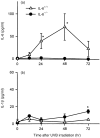Defective immune response and severe skin damage following UVB irradiation in interleukin-6-deficient mice
- PMID: 10447717
- PMCID: PMC2326816
- DOI: 10.1046/j.1365-2567.1999.00733.x
Defective immune response and severe skin damage following UVB irradiation in interleukin-6-deficient mice
Abstract
Interleukin-6 (IL-6), a multifunctional cytokine, is induced in the acute-phase reaction following ultraviolet (UV) irradiation of humans and mice. Using IL-6-deficient (IL-6-/-) mice, we investigated the role of IL-6 in immunosuppression and inflammatory responses caused by UVB (280-320 nm) radiation. The IL-6-/- mice had a defective contact hypersensitivity (CHS) in response to the sensitizers 2,4-dinitrofluorobenzene and oxazolone. The injection of recombinant IL-6 (rIL-6) into these mice resulted in a marked recovery of the CHS. Serum IL-6 was significantly elevated by UV irradiation of wild-type B6 J/129Sv (IL-6+/+) mice but was not detectable in IL-6-/- mice. Interestingly, there was no induction of serum interleukin-10 (IL-10) by UV irradiation of IL-6-/- mice, whereas UV exposure caused a significant increase in serum IL-10 levels in IL-6+/+ mice. Injection of rIL-6 into IL-6-/- mice increased IL-10 to levels similar to those of IL-6+/+ mice. Being different from IL-6+/+ mice, no epidermal proliferation was found at 48 hr in the IL-6-/- mice, but delayed cell proliferation was observed at 72 hr after UV exposure. Immunohistochemical analysis demonstrated that the epidermis was capable of synthesizing IL-6 at 72 hr after UV irradiation of IL-6+/+ mice. In addition, the IL-6-positive cells appeared to be Langerhans' cells, which were detected with dendritic cell-reactive S-100 antibody. The present study strongly suggests that IL-6 may play a crucial role in the alteration of cutaneous immune responses following UV exposure, and provides evidence that IL-6 is a potent inducer of IL-10. Furthermore, IL-6 production induced by UV radiation appears to be an important early signal for repair of UV-caused skin damage.
Figures







Similar articles
-
The role of IL-4, IL-10, and TNF-alpha in the immune suppression induced by ultraviolet radiation.J Leukoc Biol. 1994 Dec;56(6):769-75. doi: 10.1002/jlb.56.6.769. J Leukoc Biol. 1994. PMID: 7996051
-
Effect of 17beta-estradiol on immunosuppression induced by ultraviolet B irradiation.Arch Dermatol Res. 2004 Feb;295(8-9):307-11. doi: 10.1007/s00403-003-0437-0. Epub 2003 Nov 29. Arch Dermatol Res. 2004. PMID: 14648074
-
Role of tumour necrosis factor-alpha in ultraviolet B light-induced dendritic cell migration and suppression of contact hypersensitivity.Immunology. 1994 Jan;81(1):79-84. Immunology. 1994. PMID: 8132224 Free PMC article.
-
The role of cytokines in UV-induced systemic immune suppression.J Dermatol Sci. 2000 Mar;23 Suppl 1:S10-2. doi: 10.1016/s0923-1811(99)00073-0. J Dermatol Sci. 2000. PMID: 10764984 Review.
-
Ultraviolet Radiation-Induced Tolerogenic Dendritic Cells in Skin: Insights and Mechanisms.Cells. 2025 Feb 18;14(4):308. doi: 10.3390/cells14040308. Cells. 2025. PMID: 39996779 Free PMC article. Review.
Cited by
-
CD8+ IL-17-producing T cells are important in effector functions for the elicitation of contact hypersensitivity responses.J Immunol. 2006 Nov 15;177(10):6852-8. doi: 10.4049/jimmunol.177.10.6852. J Immunol. 2006. PMID: 17082599 Free PMC article.
-
Error-prone translesion replication of damaged DNA suppresses skin carcinogenesis by controlling inflammatory hyperplasia.Proc Natl Acad Sci U S A. 2009 Dec 22;106(51):21836-41. doi: 10.1073/pnas.0909507106. Epub 2009 Dec 10. Proc Natl Acad Sci U S A. 2009. PMID: 20007784 Free PMC article.
-
IL-17 and IFN-gamma mediate the elicitation of contact hypersensitivity responses by different mechanisms and both are required for optimal responses.J Immunol. 2009 Jul 15;183(2):1463-70. doi: 10.4049/jimmunol.0804108. Epub 2009 Jun 24. J Immunol. 2009. PMID: 19553527 Free PMC article.
-
Repeated doses of UVR cause minor alteration in cytokine serum levels in humans.Mediators Inflamm. 2005 Oct 24;2005(5):298-303. doi: 10.1155/MI.2005.298. Mediators Inflamm. 2005. PMID: 16258197 Free PMC article. Clinical Trial.
-
The CaSR Modulator NPS-2143 Reduced UV-Induced DNA Damage in Skh:hr1 Hairless Mice but Minimally Inhibited Skin Tumours.Int J Mol Sci. 2023 Mar 3;24(5):4921. doi: 10.3390/ijms24054921. Int J Mol Sci. 2023. PMID: 36902353 Free PMC article.
References
-
- Luger TA, Schwarz T. Effect of UV light on cytokines and neuroendocrine hormones. In: Krutmann J, Elmets C, editors. Photoimmunology. Oxford: Blackwell; 1995. p. 55.
-
- Noonan FP, Defabo EC. UV-induced immunosuppression. Relationships between changes in solar UV spectra and immunologic responses. In: Young AR, Bjorn LO, Moan J, Nultsh W, editors. Environmental UV Photobiology. New York, NY: Plenum Press; 1993. p. 113.
-
- Ullrich SE. The role of epidermal cytokines in the generation of cutaneous immune reactions and ultraviolet radiation-induced immune suppression. Photochem Photobiol. 1995;62:389. - PubMed
-
- Black HS, degruijl FR, Forbes PD, et al. New trends in photobiology (invited review) Photocarcinogenesis: an overview. Photochem Photobiol. 1997;40:29. - PubMed
Publication types
MeSH terms
Substances
LinkOut - more resources
Full Text Sources
Other Literature Sources
Molecular Biology Databases

